I sometimes wonder if I was in my right mind when planting a Seville Orange! On the face of it, of course I was…we adore Seville Orange Marmalade and I love everything about the process - the picking, the juicing, the satisfying pulling of pulp that comes away with ease to leave a clean, sweep of smooth white pith inside each bare cup of bright orange skin. But more on the making, along with the recipe, below.
Then there’s the annual progress of the next batch, that begins with the spring flush of blossom that’s inclined to arrive just as soon as the last of this season’s glorious oranges are in the jar! But like all produce, when it’s ripe it demands attention right away - there can be no quibbling or dilly-dallying; and the ripening of the Sevilles coincides precisely with the urgency required just about everywhere in the garden! Add an event or two for good measure and it’s then I begin to question my sanity in planting such a profusely fruiting tree!
Which task to tackle first? Garden or fruit? (Or Substack writing for that matter!). It makes no sense to allow a much anticipated crop go past its best, but nor can I take my eye off the once-in-the-year opportunity to divide and move herbaceous plants; complete the last of the pruning (I haven’t yet begun the fruit trees in the orchard or the roses in the field), or as I mentioned last week, to get the fertiliser out (I did do that!) and the compost and mulch on - sometimes it seems like a months’ worth of tasks need to be done in a day! Which of course they can’t possibly be - oh but how I would like a solid week without interruption in the garden! All I can say is…thank goodness for this week’s rain (didn’t I say I hoped for a shower or two at the end of last week’s post?) which put paid to outside work…so for a couple of days anyway, filled with marmalade they have been! (Although I am sorry…the Gallivanting posts are temporarily on hold, because with the Seville simply laden with huge, plump oranges oozing with juice, ripe of flesh, peel and pith; if I don’t take them from the tree, their sheer weight will break the branches at the first hint of a breeze, especially after rain.
As I write (beginning this first section on Wednesday!), the kitchen is filled with the aroma of oranges slowly bubbling away in the most enormous saucepan (the kind that’s heavy enough when empty, let alone when three quarters full!).
But where to begin? With the tree? A tangent? Or the recipe? You know by now I’m unlikely to have thought in advance of any great plan…so let’s begin with the tree without which there would be no marmalade! Imagine? In fact I just was, as I squeezed the juice from a dozen fat oranges (I use an electric squeezer these days - traditionally I’ve used the old glass one and squeezed them by hand, but my thumb/wrist situation has put paid to that which is sad, even if the new way is quicker).
If I had no tree, would I bother? Probably yes…I’d hope for either a friend with a tree or to find some at a farmer’s market…if I was lucky that is. I don’t think Sevilles are very easy to get hold of, but I’m sure those of you who are committed marmalade fiends (and I know you’re out there!) all have your source! But if I wasn’t so lucky, would I just buy a jar each time we run out? I guess so! Oh but I well know that the pleasure derived from something bought is short-lived compared to something home-made (no matter how good the bought may be!) and especially if made from something one has so delighted in growing. I can’t look at a jar of bought jam with any sense of fulfilment, or to intimately know the tree from whence it came. What I do know is that if you’re gifted jam by a friend or buy a jar at a small market stall, you can be sure that person knows their tree well and that the contents of the jar will have been made with enormous care and love.
Which brings me back to the tree! In fact it’s our second one. The first took its time to grow, fruited for many years, then curled up its toes. I never got to the bottom of why (although it was next to that white wisteria I mentioned some posts ago, that also died mysteriously and suspect the two fatalities were connected in some way…Larry still blames a painter!). Perhaps against my better judgement, I planted a replacement in the same spot (with a good amount of clearing out of the original hole and adding new compost) but my gamble seemed to work. This one also took its time to establish, but by now too, has been thriving for years (I hope I’m not jinxing it by saying so!).
There were a few years in between without home-made marmalade! Luckily, Larry’s godfather was still alive and I recall a couple of times, him sending a rescue hamper filled with jars of Keiller’s Dundee Seville Orange Marmalade! (Goodness…had I not embarked upon writing this I’d have completely forgotten about our surprise at the arrival of such a box of those very distinctive, opaque, greyish/white jars with black lettering and illustration of bright oranges!).
I just went a-googling out of curiosity and look what I found: Then, according to Scottish legend, the Seville orange became a popular choice when a storm-damaged Spanish ship carrying a cargo of the oranges sought shelter in Dundee harbour in 1797. The Keiller family bought the oranges and used them for marmalade – hence the fame of Dundee Marmalade with its bittersweet taste.
There you go! If I had time I’d do more research into the history of marmalade to share with you - I know it’s written in the book from which I found the recipe…one that belonged to Larry’s mother called Farmhouse Cookery and from which I have learned a great deal. For us, the whole marmalade saga is indeed wrapped up in Larry’s family tradition, hailing from Scotland as he does. Hence his godfather with the same tradition, sending packages of marmalade to the rescue, when he heard his wayward godson (whom he no doubt believed had made an utterly stupid decision in moving down under at all!) was without his favourite marmalade for breakfast!
By the time I met Larry, my tastebuds must have been adult enough to enjoy the bittersweet taste (or maybe I was just in love!). Can’t recall! But either way I soon developed an appreciation for it and whilst he may enjoy it on his toast each morning, personally I save it for special celebratory breakfasts (abstemious as I’m inclined to be with my regular daily diet - don’t worry - I know when to make up for it!) like at Christmas and Easter, when I reckon I deserve a decent dollop and brain fog be damned!
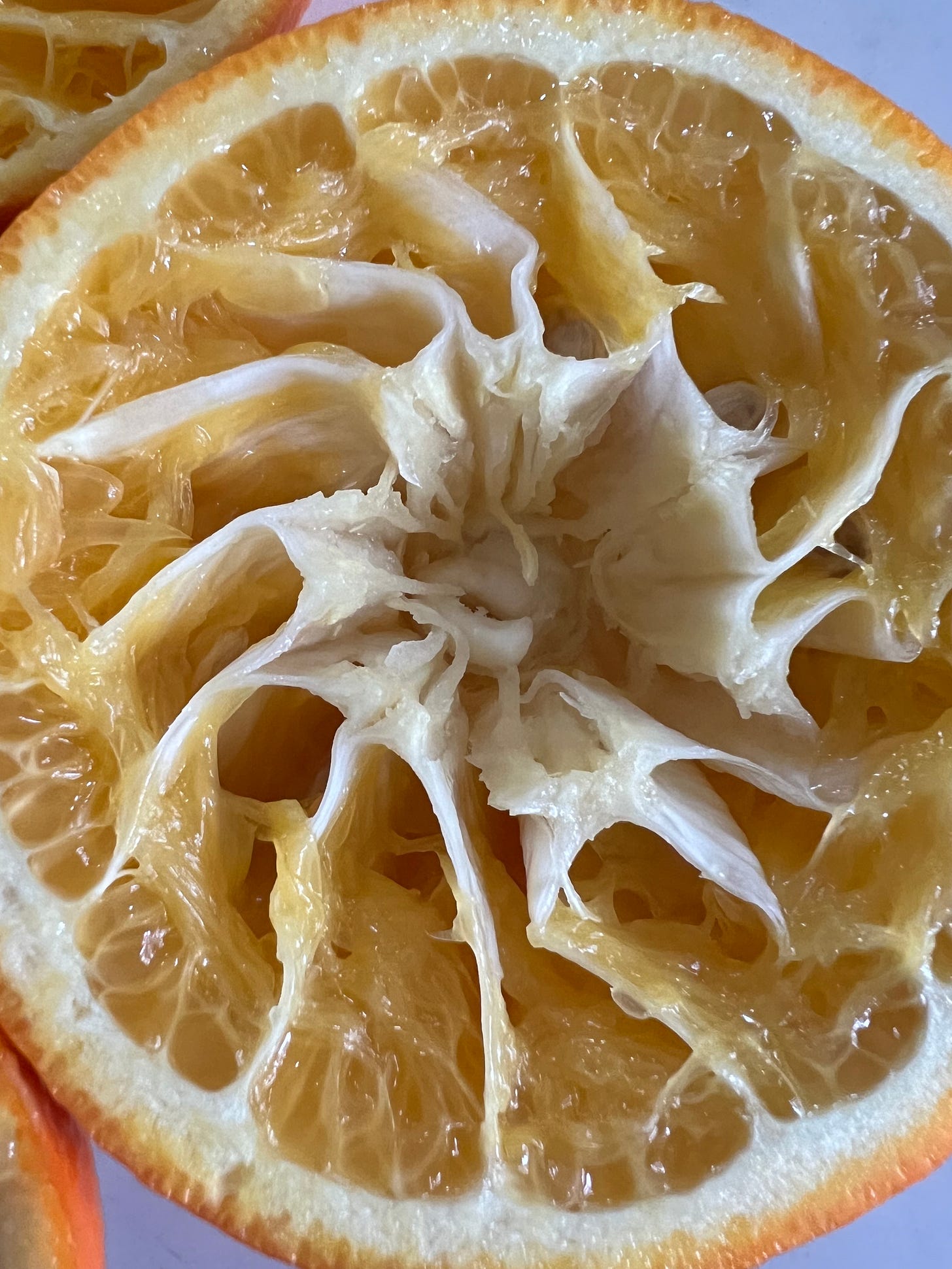
But back to the tree! It is a decent size now and certainly I don’t need it to get any larger in hope of producing more fruit…it produces plenty for us and to give to marmalade making friends. I can manage the tree at the size it’s at - any taller and I would struggle to net it (as annoyingly I do thanks to you know what!). Its crown is dense enough to diffuse some of the punishing heat from the verandah during the summer months without obscuring the view across to the sparkling waters of the dam from the kitchen sink. And…it produces enough new branches of vibrant green leaves in the spring, along with its ‘little fruit’ to go towards making an annual batch of Petitgrain Botanical Water!
The first batch of marmalade I ever made was from Cumquats picked from a small tree the year we came to Glenmore. It was an ugly thing…of variegated leaf colour and sitting as a misplaced specimen close to a eucalypt. Its fruit though, were plentiful and I remember taking a huge basket load back to our tiny house in Sydney (this was all well before we embarked on the whole restoration and were only weekend working-bee and picnicking). At the time of the first marmalade-making episode, I was pregnant and suffered dreadfully with morning sickness, but recall sitting in the sun in our little courtyard, patiently halving and de-seeding what seemed like a never-ending mountain of fruit! The result though, was simply sublime. I honestly believe cumquats make the very best marmalade of all. Seville Orange runs a close second! We lost that tree when we tried to move it in the early years, though not before I’d made a good three or four batches. And then I managed to get enough from a pair of cumquats in terracotta pots I kept in the Hayshed for a long time. Then they died during a drought (during the last one we ran out of water and they didn’t enjoy the water from the bore)…so I’ve planted one tucked close into the house, just along from the Seville and slowly, oh so slowly, it too is making progress.
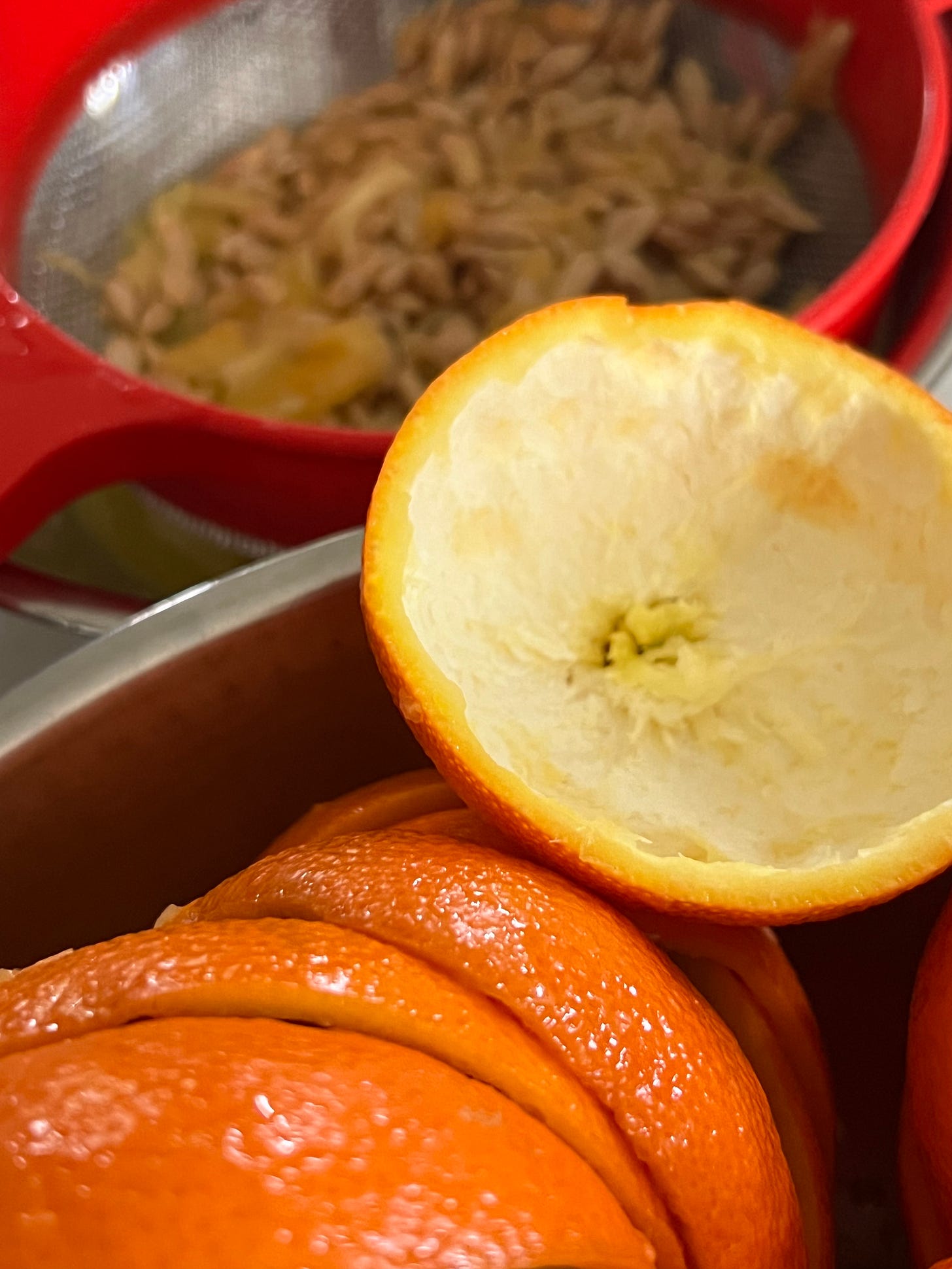
A note for new gardeners: persevere with citrus trees - they are slow to establish, sometimes taking years, but once they do, then you should have them for a good while. Our established citrus have been in for over thirty years and have been productive for a very long time.
Ready for the recipe?
Seville Orange Marmalade
Ingredients (can never resist adding the old imperial measurements for this one!)
3lb / 1.4kg Seville oranges
5 pints / 2.8 litres water
Juice of 2 lemons
6lb / 2.7kg sugar (I use 2kg)
Yield: approx 10 - 12 270ml jars
Method
First, scrub the oranges - even organically grown ones attract dust and especially if it hasn’t rained in awhile!
Halve the oranges
Squeeze all the juice and strain into a big saucepan with a lid (keep all the pips!)
Take each squeezed orange half and remove all the pulp (it comes away in a very satisfactory manner once you nick the first segment), so you’re then left with a heap of empty skins
As you cut the pulp roughly, check for any pips that may have been trapped in the little individual pulp sacs, then add the pulp to the juice in the pan
Cut the skins: I find cutting them into quarters helps. Cut as you like - we tend to do thin lengths rather than chunks but each to their own! Add the chopped skins to the juice and pulp in the pan (I did have to ask Clemmie to do the slicing this year…in trying to repair my thumb/wrist, it’s this part of the job that causes the stress…uggghhh….)
Pour in the water
Tie all the pips into a piece of muslin, then hang the muslin (I tie it to the pan handle) deep into the water
Bring to a simmer and cook gently for 2 hours
Now is a good time to clean up all the mess! Measure out the sugar, squeeze the lemons and get your jars ready to sterilise (begin a substack post!)
When 2 hours are up, take the pan off the heat, detach the bag of pips, squeeze it against the side of the pan and discard (pips are rich in pectin which jam needs in order to set)
Add lemon juice and sugar, being sure to stir the sugar in well….I tend to do figures of eight with a wooden spoon as well as stirring around and around…making sure I can feel it’s all dissolved
Return to the heat, pop the lid on to bring to the boil, then remove the lid and cook rapidly until setting point is reached: during this period the marmalade will darken considerably in colour. I find this second stage can take up to 2 hours
To test for setting point, place a saucer into the fridge so that it’s cold. Take a teaspoon of marmalade from the pan and tip onto the cold saucer. Leave for one minute and if setting point has been achieved, the marmalade will wrinkle when you push it gently with your finger
Once setting point is reached, turn off the heat and allow to stand for 5-8 minutes before skimming any scum from the top
While waiting for the marmalade to stand, make sure you have everything at the ready to fill your jars: sterilised jars, lids, tongs, ladle and jam funnel
Hopefully you won’t make too much mess! Don’t screw the lids on too tight while the marmalade is hot - I generally leave them to cool overnight and give them an extra tightening twist next morning…when you can enjoy the first dollop on your toast!
This week’s batch is particularly dark in colour - I don’t know why, but there it is. It’s bittersweet and strong...and I just might have to have a piece of toast tomorrow morning! You’ve heard me mention Belinda Jeffery’s Pumpernickel Soda Bread so many times by now (and I’m unlikely to stop mentioning it any time soon!) as I really do bake it regularly and for almost every event here. I can tell you that a slice of that bread toasted, slathered with butter and topped with a good dollop of Seville orange marmalade is one of the most delish things on earth!
Friday…and I’ve just finished moving all the furniture in the Dairy in preparation for our Thankful for Soil event on Sunday!
Despite what I’ve written above, I did manage a lot of gardening at the weekend…I divided the Sedum and pruned the Buddleias as well as doing a lot of fine tuning in the Borders. I pruned all the garden roses (just not the ones in the field!) and dished out a great deal of Dynamic Lifter (pelletised chook manure). Then the rain properly watered it in a few days later…exactly as hoped. I wish I’d got ahead with more of that work but I can only go as fast as I can go!
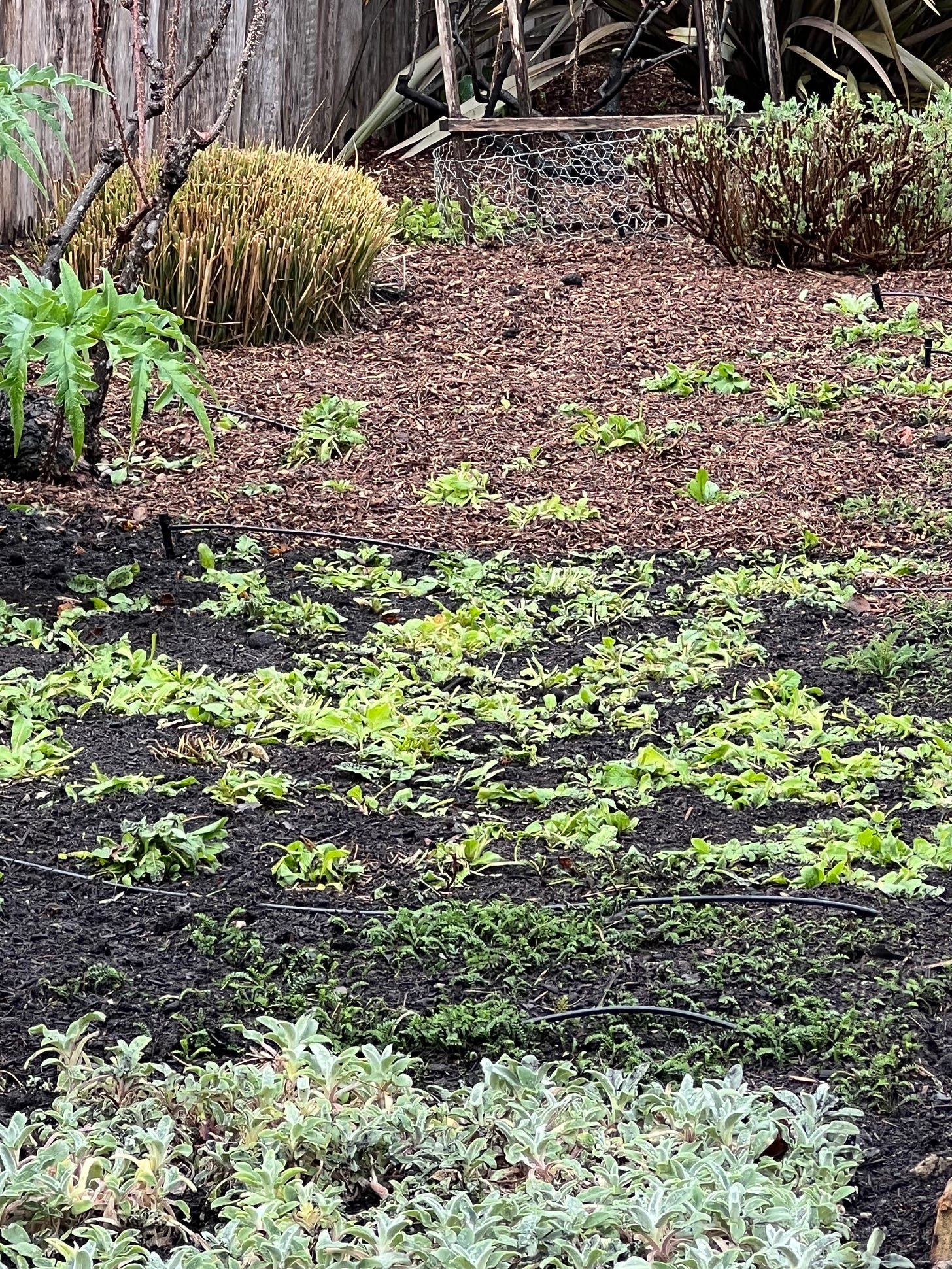
At the beginning of the week, before the rain, Thalia managed to add compost to one of the borders and to get half way through with mulch too. The remainder will have to keep ‘til next week. I hope these two images above will give a good indication of how we care for the garden beds here: I follow the same principles I have done since the beginning, when we began making the garden based on no-dig principles (see a few posts back).
I mentioned last week that I felt the soil was at its lowest ebb in the annual cycle - in the top image it looks bare and unloved (the latter is not the case!), for want of a better description….its last layer of mulch has all but broken down. As I chose to divide some of the sedums this year, I did dig a few shallow holes to increase the size of some smaller clumps (obviously you have to dig to plant!) and was just thrilled to find the soil where I did was alive with earthworms…and upon breaking the surface, it was not so compacted as it looks from above. That makes me smile…we’re on track.
And so the same regime will continue as it always has done: having dealt with the requirement of each individual plant, all focus is now on the soil…feeding it with fertiliser and compost…and then protecting it with a fine layer of mulch over the compost, which will do several things: suppress weeds, increase microbial activity below and help to retain moisture. I’m inclined to alter which mulch we use from time to time. These forest fines are my least favourite, as they don’t break down quickly enough to my way of thinking - meaning the garden may not get its full dose of compost again for a couple of years (and I wouldn’t dream of using it in the kitchen garden). But the ornamental beds have had several years of hemp mulch which I can no longer get hold of and I’m loathe to use sugar cane in the ornamental beds (well, anywhere really as I’ve mentioned before I find it causes the soil to become hydrophobic, ie to repel water) but locally, it’s the easiest for us to get hold of.
Once the Borders are fully composted and mulched, it will be time to move on to the Barn Garden, the Arc, Mrs R’s and lastly the Courtyard. I always leave the Courtyard ‘til last as we’re inclined to get spring winds and the huge peppercorn then drops loads of leaves, spoiling our efforts! I still have some pruning to do in there too. And then of course there’s the Field which is a whole other story!
I cut back the hydrangeas…goodness how could I forget? Saturday already seems like an age ago! Pairs of buds plumping up all over made it an easy task and although I could have gone in harder…I thought not to be too severe this year. I hope they don’t get leggy though. I might feed them with some dynamic lifter and top up their mulch, but I’ll not do anything else. Hydrangeas are really pretty low maintenance…until that is, the heat is on…and then, I’ll take you on some hydrangea fun and games!
I tied in the peas and left them net-free over two days…keeping a close eye as best I could on the antics of the birds! I popped the nets back on at last light though, as I know the birds are active in the early hours. By now, after the rain, they’re bursting out of the nets and…pea-crunching time (just like broad bean tip time) is most definitely on!
I couldn’t resist opening one pod of the shelling ‘Telephone’ pea (I do often wonder who names these things!) - its peas are the sweetest of them all. But I’ve been munching sugar snaps more frequently and there are enough of them now to bring inside to add a tantalising flourish of spring to our plates.
I think its worth mentioning, while I think of it, that in the autumn we sowed a green manure crop into one of the beds where I had potatoes the previous season, on the edge of the kitchen garden. It went ballistic in the rain and so the time was right to…
Cut it down! Thalia went about that task with glee…and here it can sit, chopped and hopefully feeding the soil as it breaks down. I’m not yet entirely sure what I’ll do here this coming season although I’m tempted to put potatoes back in again.
The almond, our longtime harbinger of spring has sprung into blossom! One of the very first trees we planted (to remind us of the visions of blossoming trees we so loved when we’d visit Larry’s Pa in Mallorca all those years ago). The jasmine at the Pantry has just opened its first tiny flowers too - but is otherwise smothered in deep pink buds. I noticed the jasmine first with my nose - as I zipped out the back door of the Dairy to pick some herbs yesterday, the air was flooded with that flower’s sweet scent, despite only four or five tiny flowers being open. How thrilling….truly…I love this moment on the brink, the cusp…when all is about to unfold. (Including a thunderstorm that’s hovering over my left shoulder!).
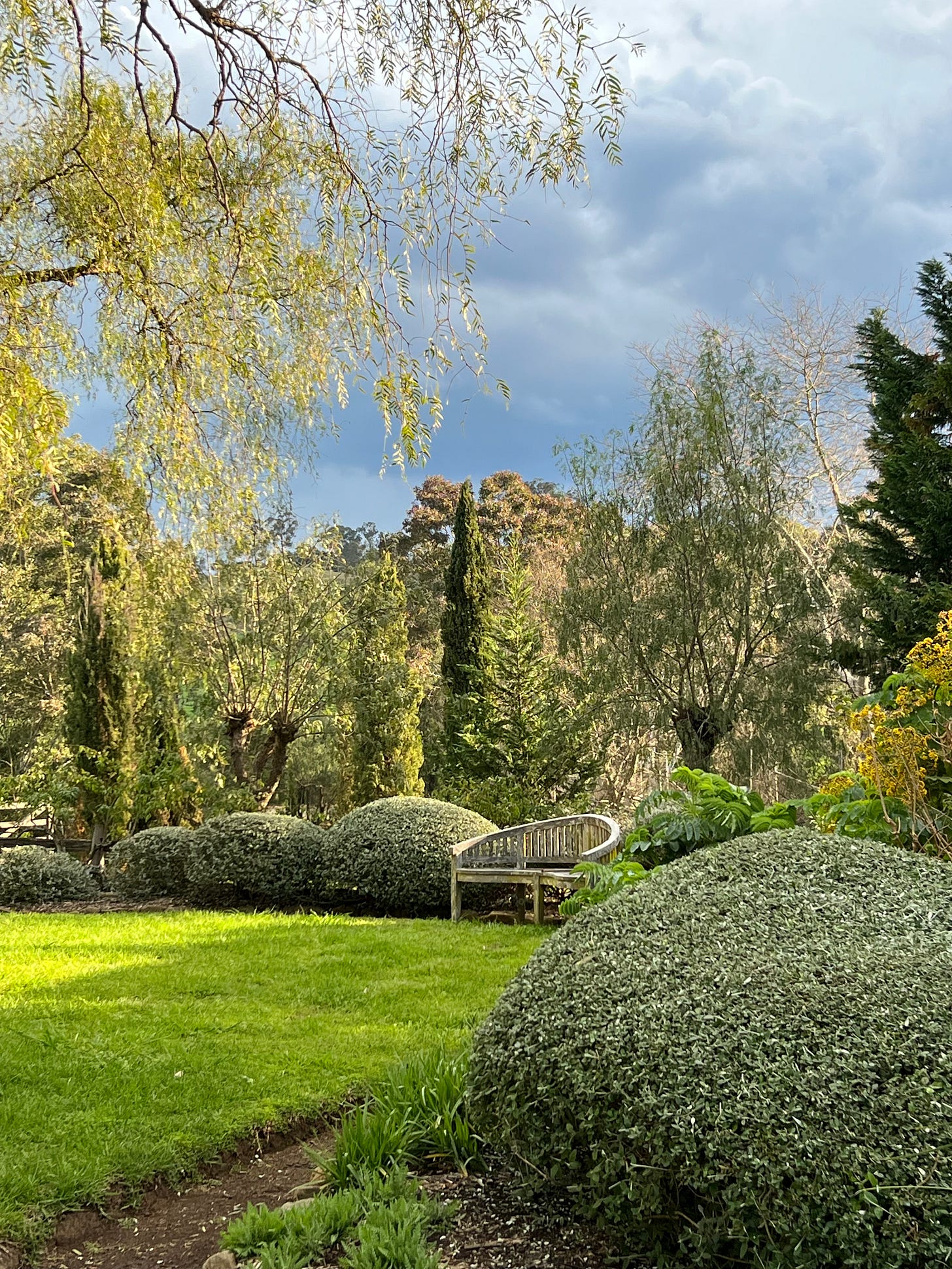
So with that…I’ll save the rest for next week in case we lose connection! I’m not yet done with marmalade…there are several more batches in the wings, but they must wait ‘til next week. Having moved the furniture and strung up the canvas and hessian at the windows in the Dairy, I’ll be cooking tomorrow! The monster batch of chicken broth is done, the pumpkins are underway, but there are cakes to bake and a whole lotta china to run through the dishwasher. I am so excited about our Thankful for Soil event - and will report back on that next week! Incidentally…the following week I have Phoebe from Alchemilla Studio coming to talk about Lunar Cultivation and the release of her latest Almanac - means a year of seed-sowing is sorted (alongside the most enormous amount of valuable growing information). We did rather spring the timing on ourselves and everyone else, given we want everyone to have maximum use of her just released 2024/25 Almanac…and have plenty of spaces to fill! How we’d love to see you here or anyone you know who may be interested in growing in true tandem with our cosmos. You can read more about the event here and also follow the links from there to Phoebe’s website which is something I’m sure you’ll love diving into!
I have a funny feeling I’ve failed to mention pumpkins in the ‘eating’ notes all these weeks! We’ve been going through them so fast…they’re almost coming to an end!
Wishing you a wonderful week ahead.
Mickey x
Productive garden notes:
Eating from the garden:
Navel oranges, mandarins (going), Lisbon lemons, rhubarb; Jerusalem artichoke, parsnip. All these weeks since May…we’ve been eating pumpkins! Leaves of all kinds - spinach, kale - cavolo nero (Red Russian is still growing on), leeks, lettuce, radicchio, rocket, red elk mustard leaf, warrigal greens. Cauliflower, broccoli, fennel bulbs, radish. Peas (new) and broad bean tips - both morsels of pure delight! I still haven’t pulled the Savoy Cabbage! Fennel fronds, parsley, mint, rosemary, thyme, chives, coriander, nasturtium and calendula petals, borage flowers.
Going / gone: Meyer lemons, tomatoes - I intend to bake the ones I showed you last weekend tomorrow - they’ve been on the bench all week and one more day will see them ready!
Seed saving: the ornamental carrot flower from down the back…it’s now dry and ripe -or was dry before the storm - I’ll bring it in tomorrow!
Sowing: lettuce and rocket are on my sowing wishlist! Most of the tomatoes have germinated which means it’s nail-biting time!
Planting: none although I’d like to get some lettuce seedlings but will have to wait for the next market. That said I’ve noted a few popping up from seed in odd places so I might do some transplanting!
Ornamental garden notes:
Picking for the house: I brought those pretty heads of hydrangea inside and another solandra trumpet. I dare say the first sprig of jasmine will be in tomorrow!
Perfumes and aromas: As I went about my work at the hydrangeas, the air was flooded with the perfume of Daphne drifting from the courtyard; then working in the Borders was pure joy as waves of Osmanthus scent permeated the air. It was later joined by the strong odour of dynamic lifter and truly? That combination…(you may laugh!) is so evocative of this time of year - it’s the true smell of a good August gardening weekend! Wonder if we can bottle it?
Pruning and other: Hydrangeas, buddleias, garden roses and the philadelphus in the Arc were all pruned. Sedums in the Borders divided. Thalia gave the Teucriums in the Arc a haircut and began the lengthy job of trailering in the compost and mulch to the Borders (how I wish I was doing it!). Otherwise she cleared all the lawn gutters of detritus in preparation for Sunday’s visitors and today…helped me move all the tables into position for the event!

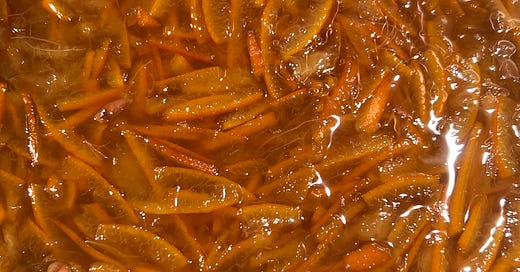



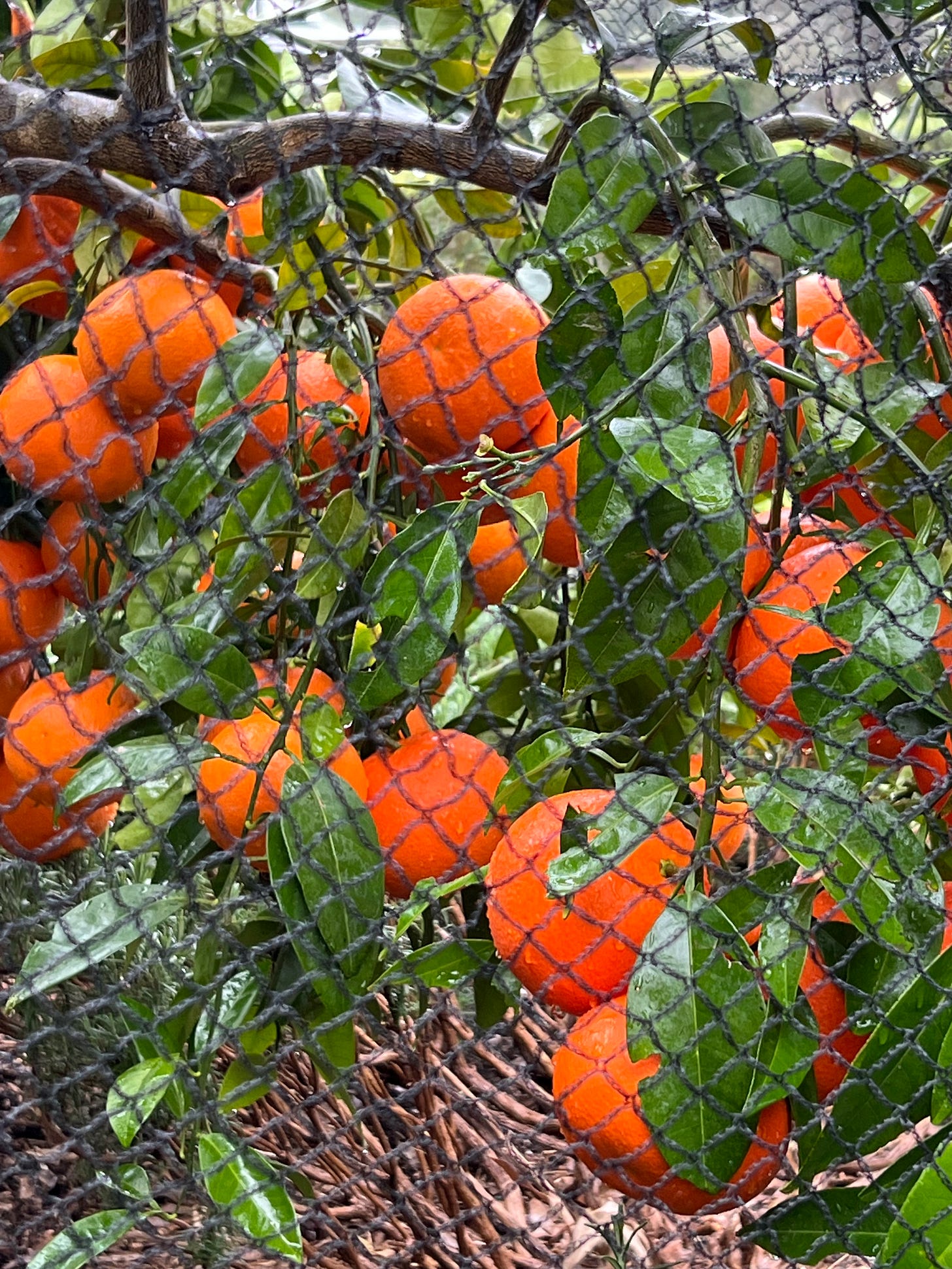
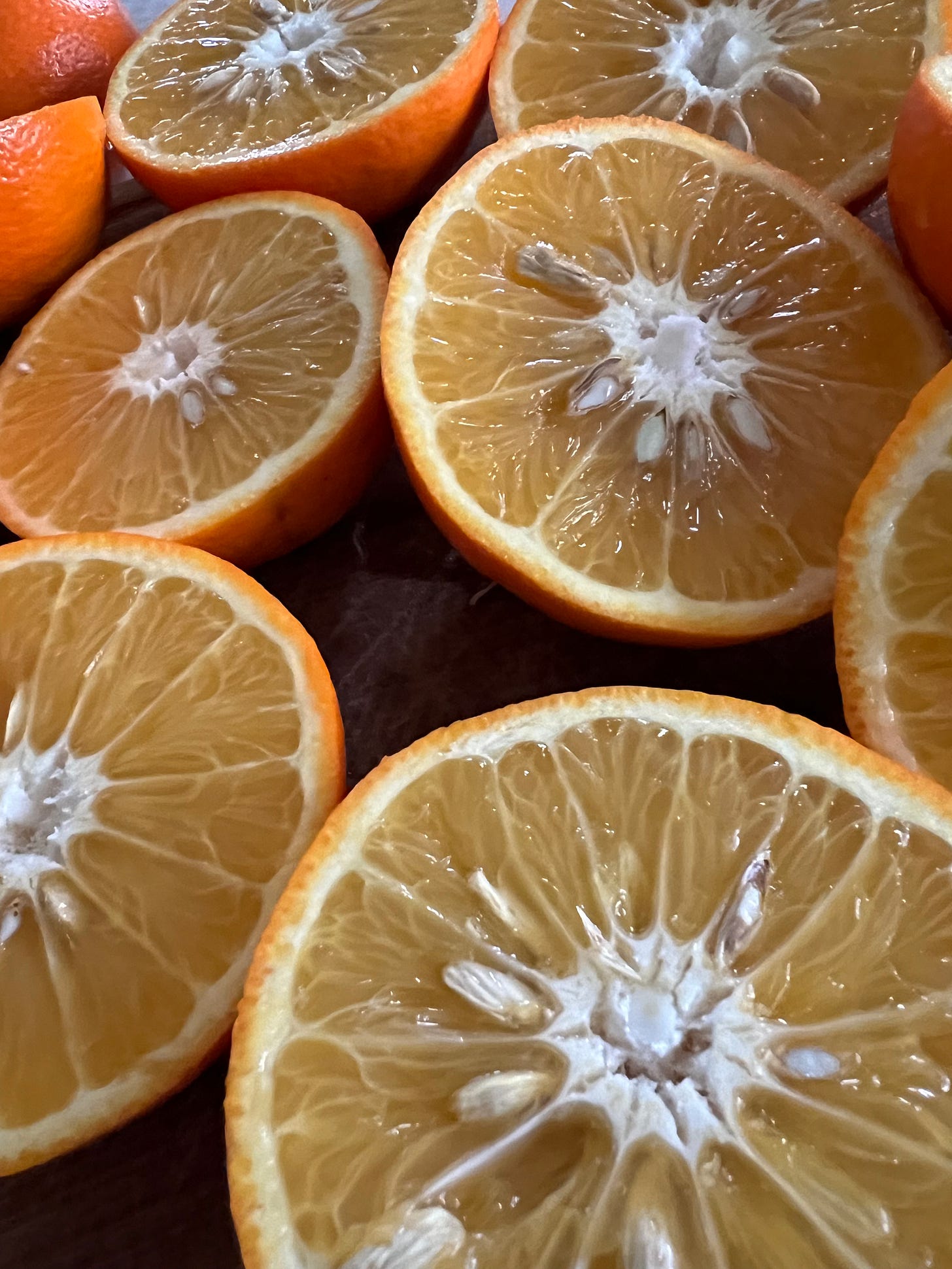
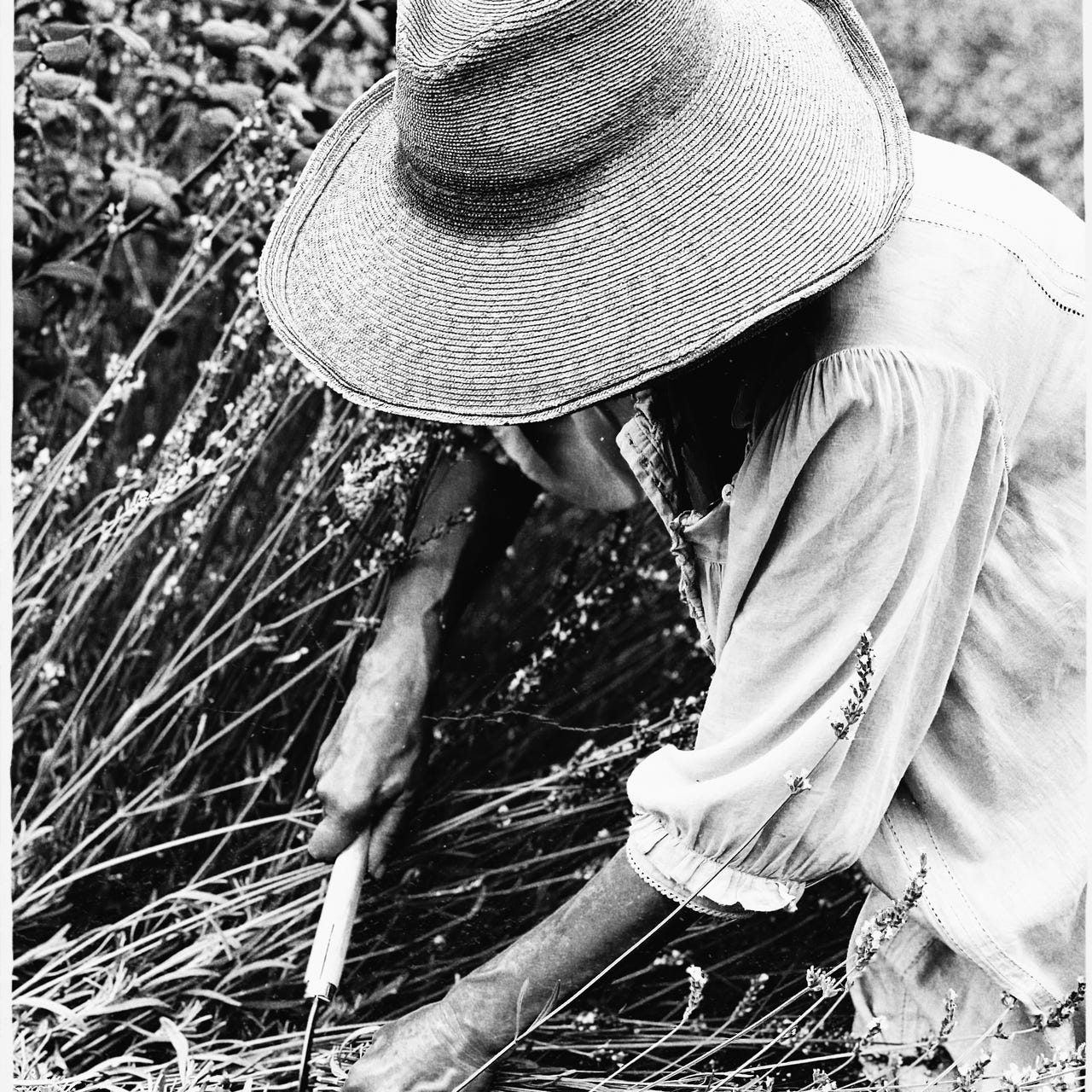

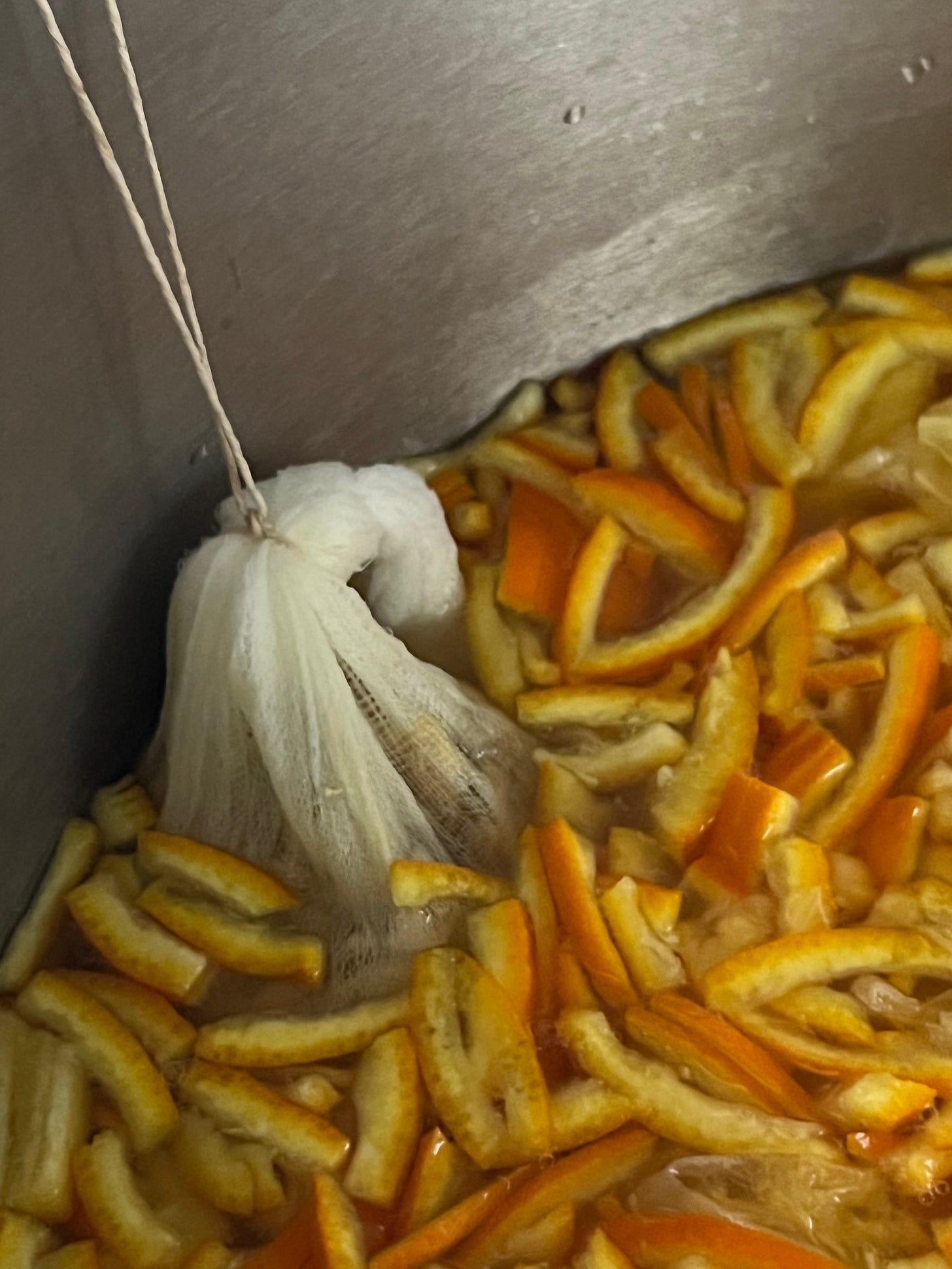
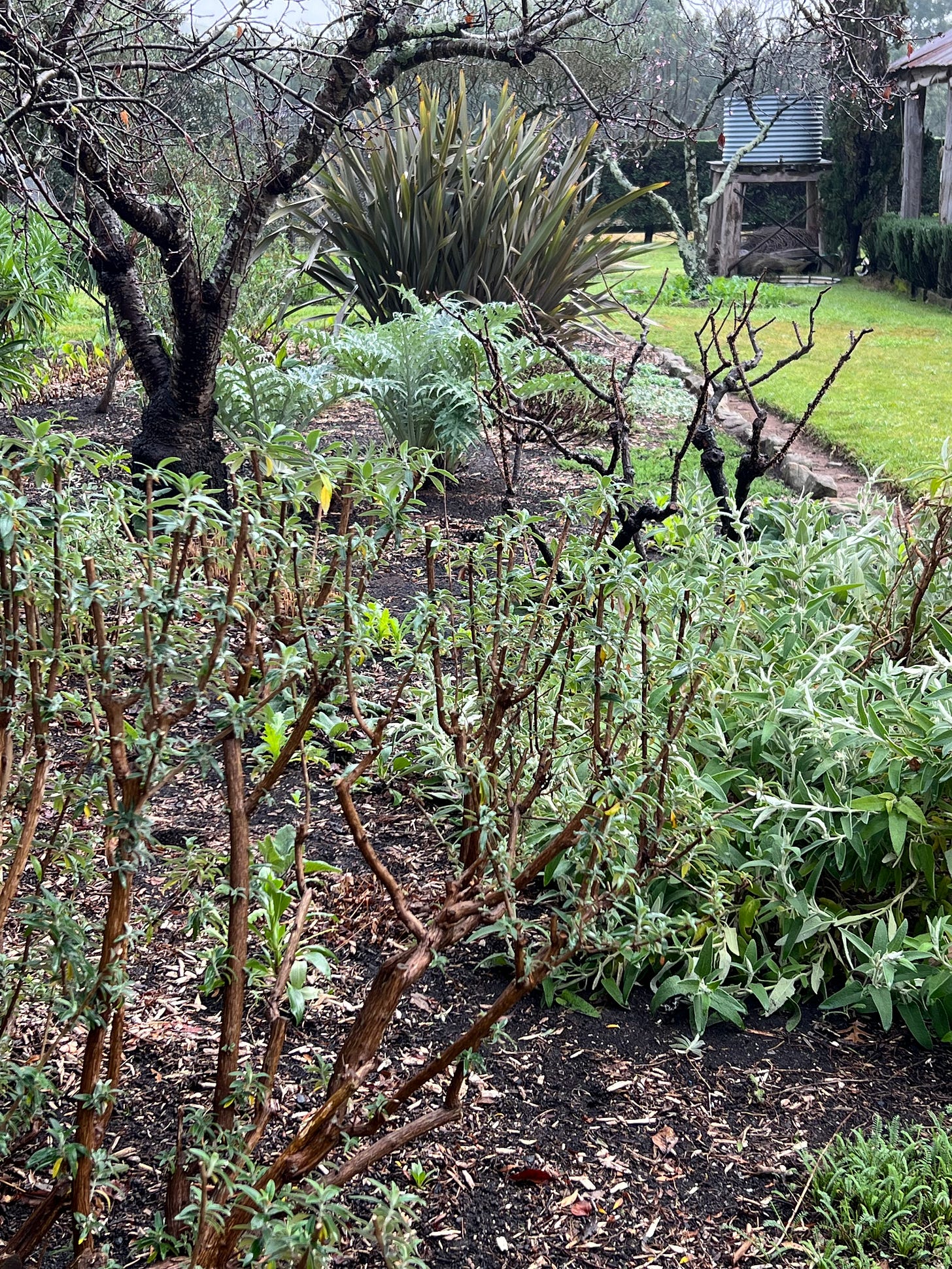
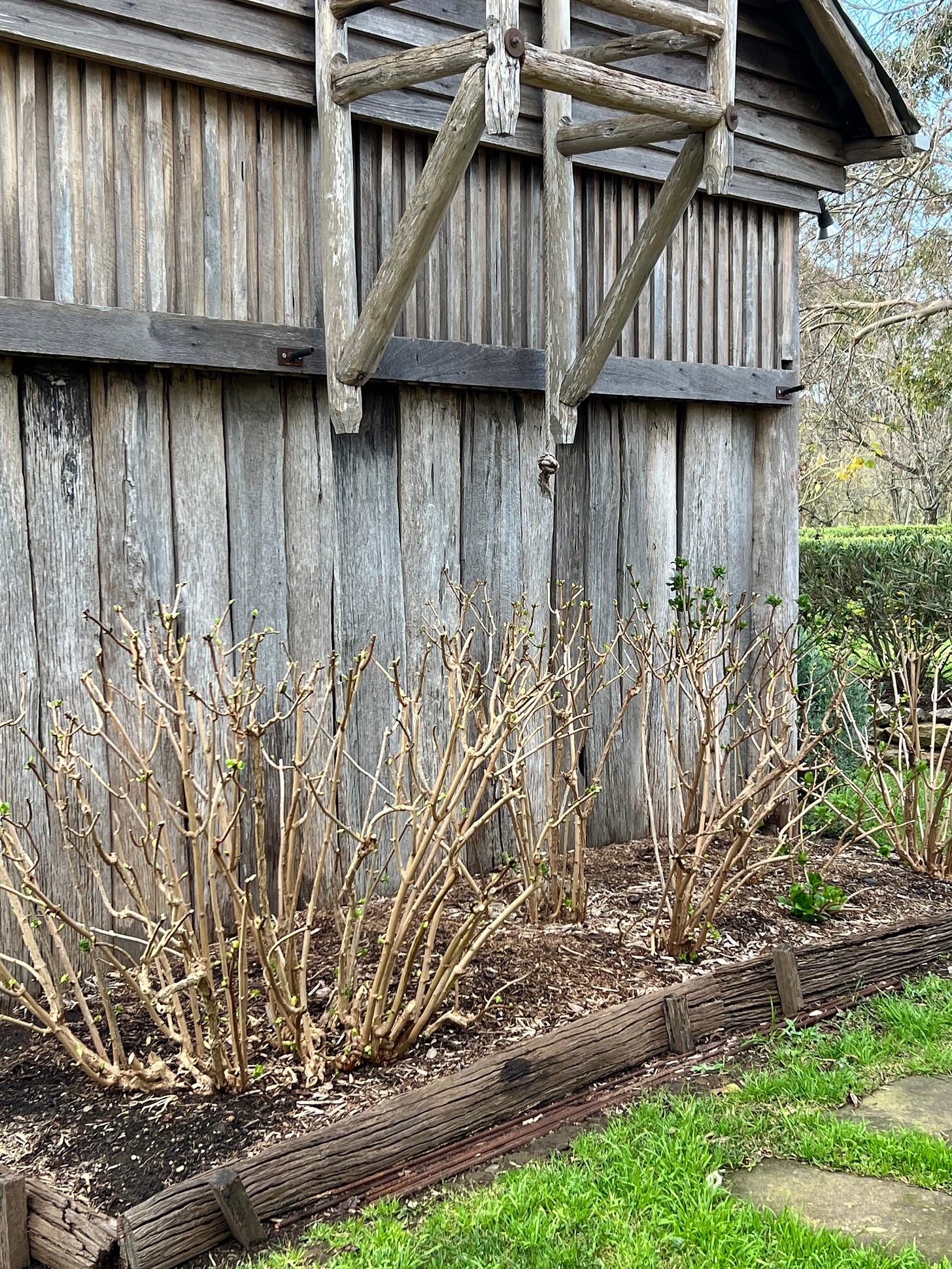
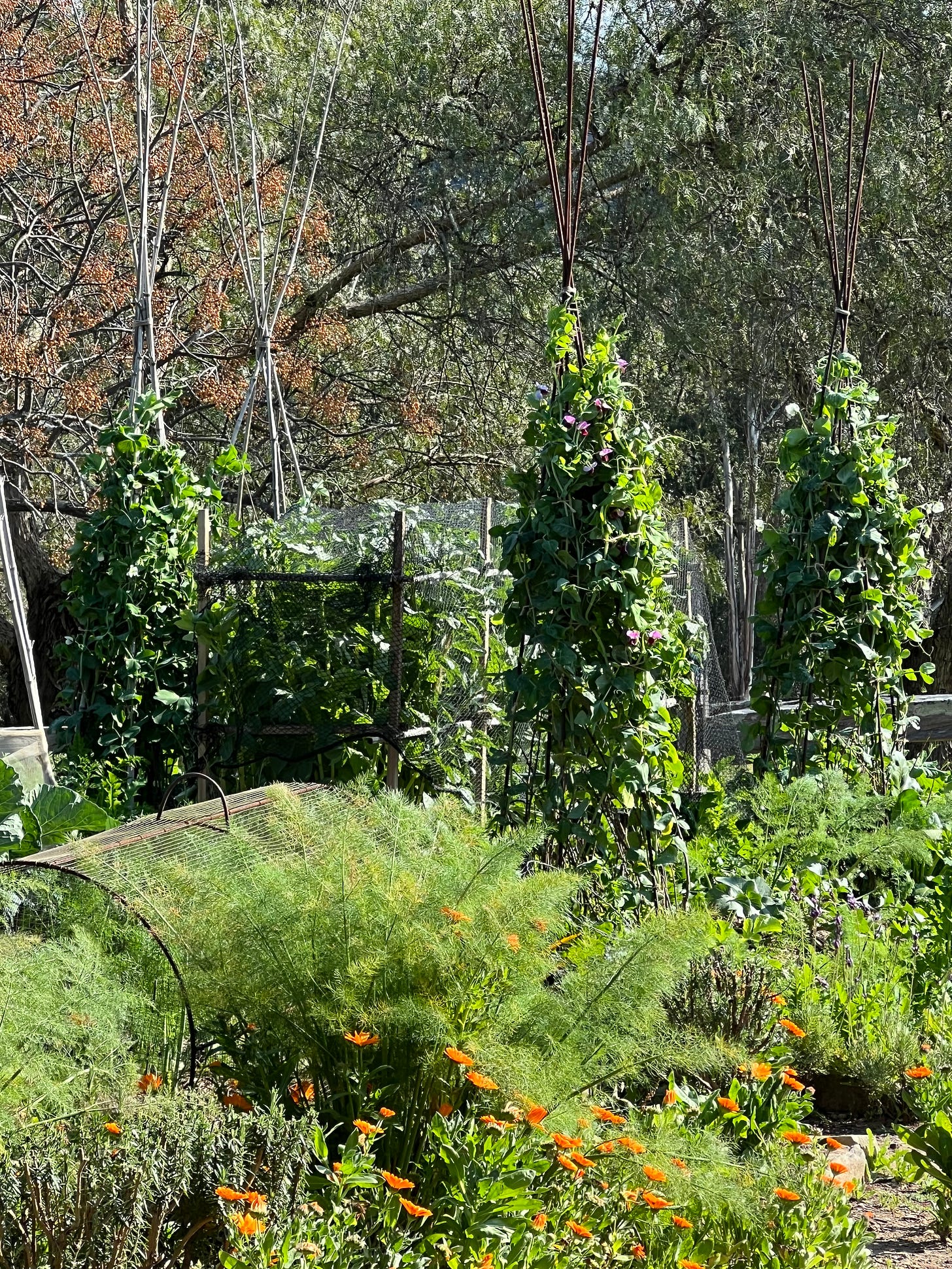

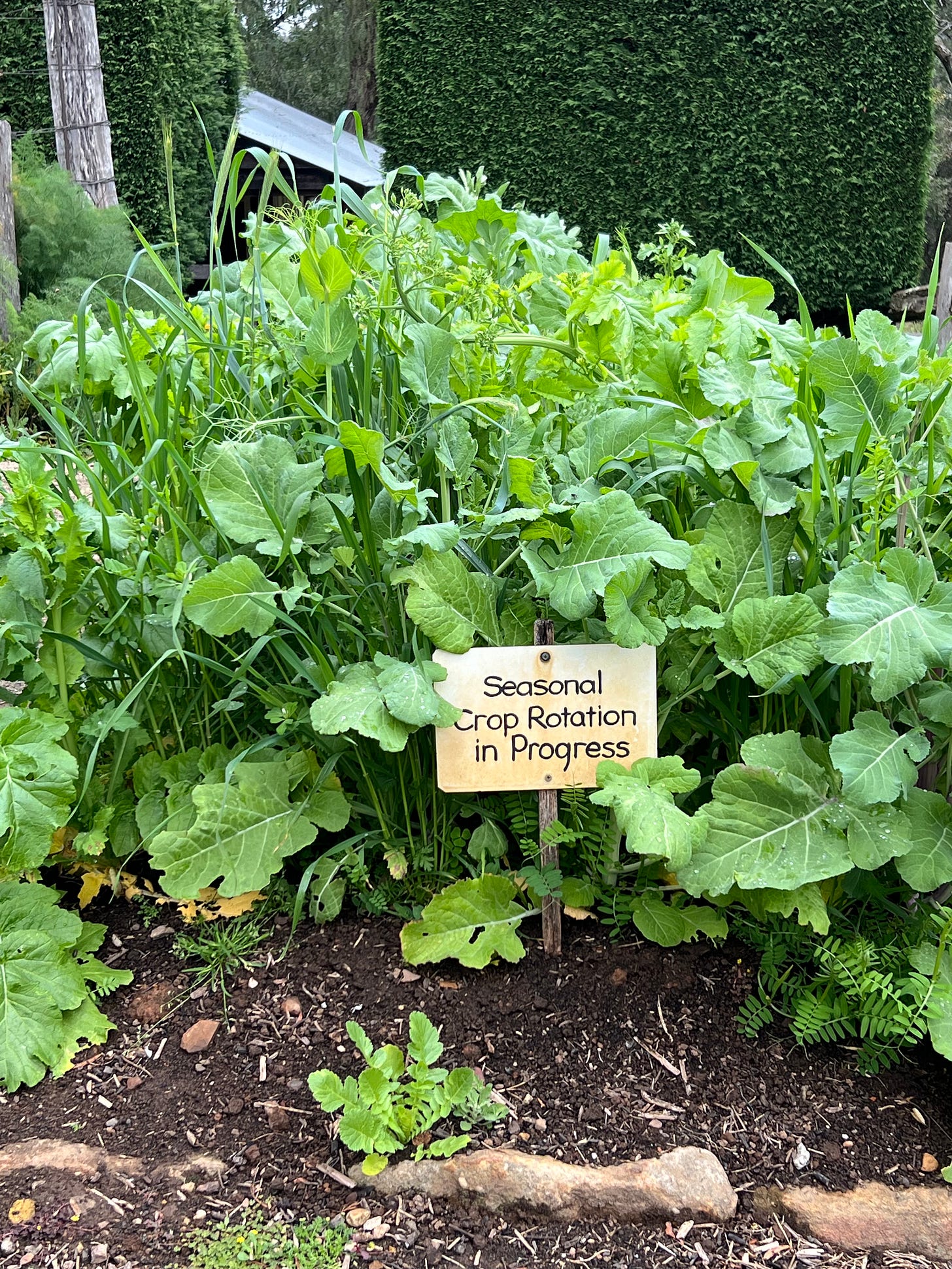
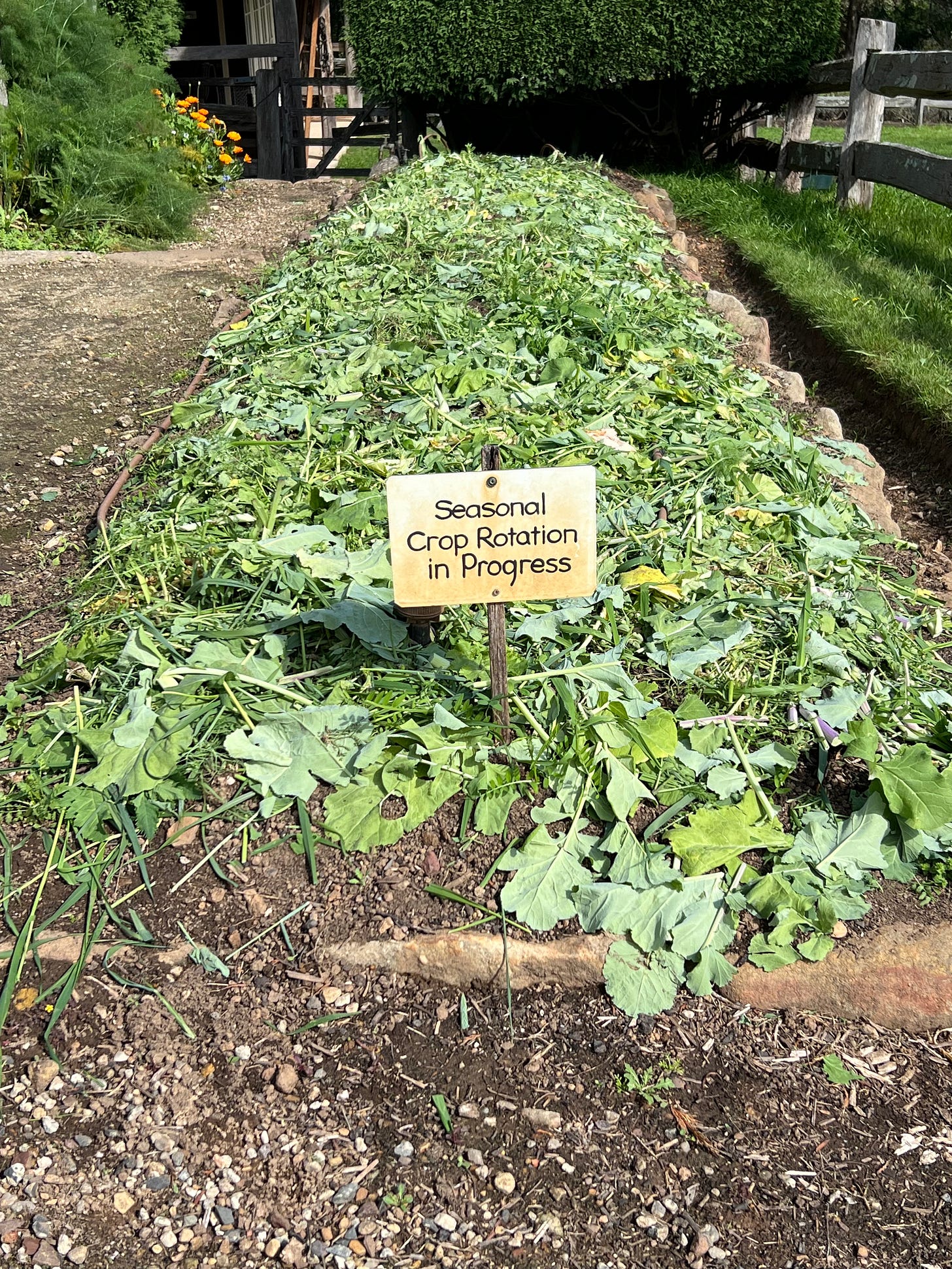
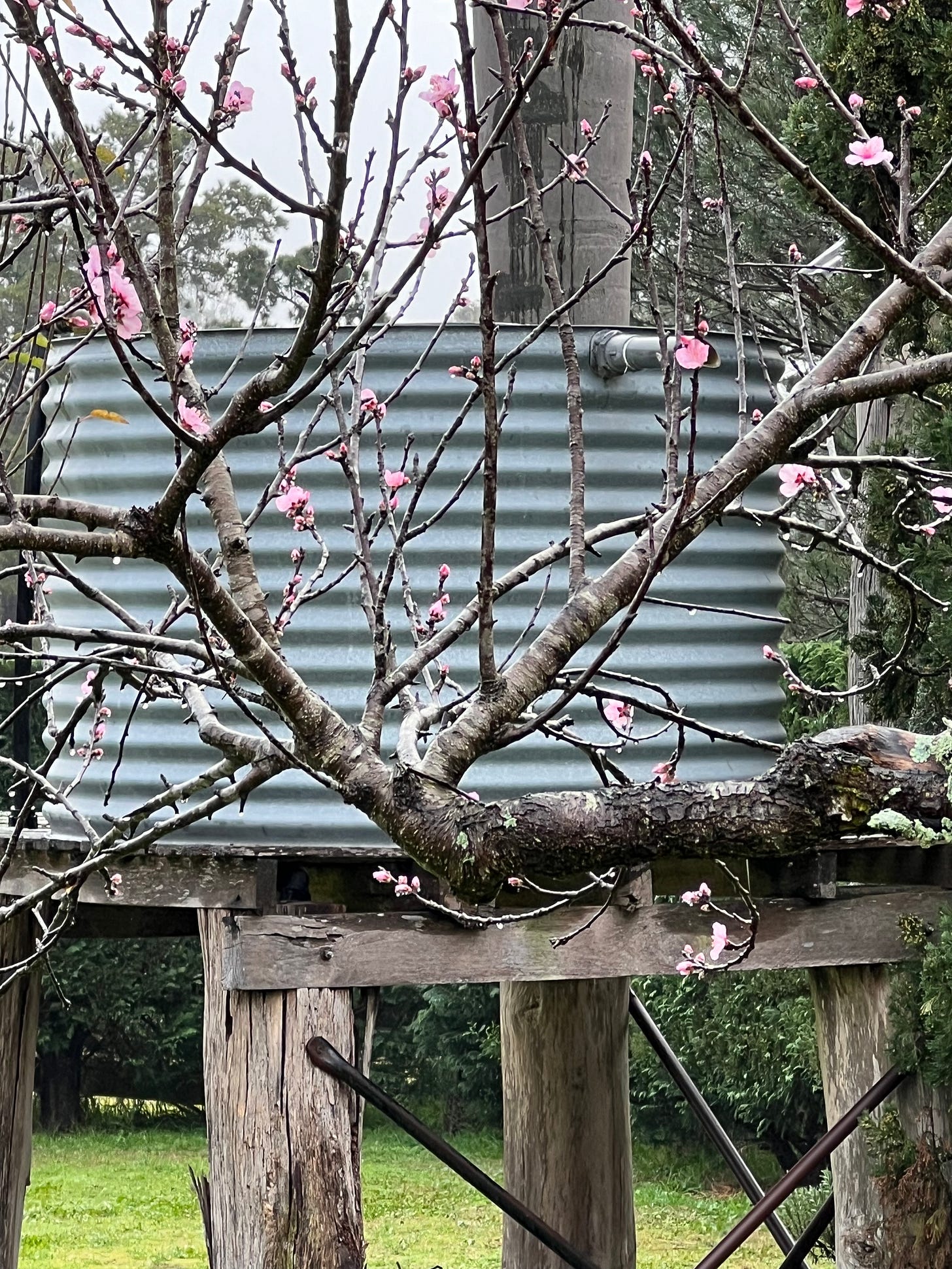

Oh Elizabeth! You're in Fiji????? Please inhale the Frangipanis for me - ours are months off flowering. As for your jam pan - what else is excess luggage for? Are you coming home or have we lost you to the islands? Sending love. Mx
And I'm with you on the caramelisation dear India...though perhaps this time I've gone too far! I can't blame sheep but drought definitely. Do replace your cumquat - at this rate we are both some years off making a batch of that glorious stuff!